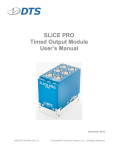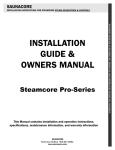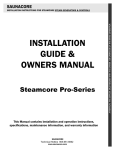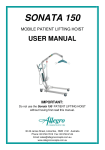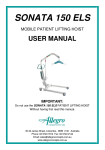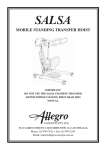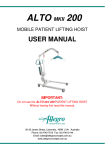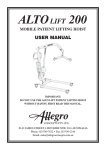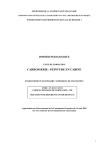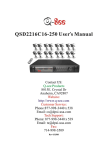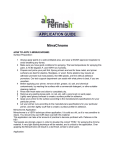Download Alsa Refinish CFXPumpsys Instructions / Assembly
Transcript
Chrome FX Pump System How to Apply (Application Steps) Congratulations! You have just purchased the most unique, do-it-yourself, home chroming system available anywhere. While this application can take a little practice to get really good at, if you follow these steps carefully, with a little practice, you should be able to create a mirror finish on nearly anything you can imagine. PATIENCE is the key. PATIENCE WILL CHROME ANYTHING. Failure at any point in the application will result in TOTAL failure of the entire application, and it will need to be re-started from the beginning, including the base coat. PLEASE NOTE: This “Pump System” is intended for small items only. 6 inches in diameter or smaller. Surface preparation: The preparation of your surface is extremely important to this process. This finish requires an EXTREMELY smooth surface, in order to achieve 100% reflectivity. The farther away from a glass smooth surface you have, the less reflectivity will be achieved. If you part is ALREADY PAINTED, you do not need to prime it. Simply sand it with 1000-1200 grit sand paper, or lightly scuff it with a grey 3M Scotch Brite 1 Always apply paints in a well-ventilated area, and wear a NIOSH approved respirator to avoid breathing any fumes. 2 Make sure you have good conditions for spraying. The best temperature for spraying this paint, is 75-80 degrees F, and VERY low humidity. 3 Prepare and prime your part first. Epoxy primers are best for bare metal, and primer surfacers are best for plastics, fiberglass, or wood. Some plastics may require an adhesion promoter but most plastics, like ABS plastic, are fine without adhesion promoters. Our tech support department can assist with what primer is best, if you are uncertain. 4 Before applying your primer, remove all dirt, grease, oil, salt, and chemical contaminants, by washing the surface with a commercial detergent, or other suitable cleaning method. 5 Rinse with fresh water and allow to completely dry. 6 Remove any existing loose paint, or rust, etc, with a wire brush or sand paper. 7 Lightly sand glossy surfaces to create a surface profile for adhesion. 8 Apply your primer to the surface according to the manufacturers specifications for your particular primer. 9 Let your primer cure according to the manufacturers specifications for your particular primer, and then lightly scuff that to create a surface profile for adhesion. Base Coat: (All mixing ratios are by volume and not by weight) The ChromeFX base coat is mixed 4:1 with its hardener. 4 parts base coat, to one part hardener. Mix the base coat in one of the plastic cups provided, and then pour it into the tall black plastic jar labeled “BASE COAT” provided in your kit. Attach one of the Preval sprayers with the plastic tube on it, onto the black plastic bottle with your base coat in it, by inserting the tube into the bottle, and screwing the sprayer on top. If this tube has come off during shipping, simply re-attach the tube to the PreVal sprayer, and proceed as described. DO NOT TILT YOUR PREVAL SPRAYER MORE THAN 45 DEGREES WHEN SPRAYING, AND DO NOT SHAKE THIS MATERIAL IN THE SPRAYER. Be sure to secure your piece with a wood stick, or clamp for the whole process of chroming, as materials under pressure can potentially move your pieces around. Especially small ones. Apply the ChromeFX base coat in one light coat, followed by one heavy coat, or 2 medium coats with about 5-10 minutes between coats, and allow to air dry for 24 hours at 75 F.If temperature is lower, it will take longer to dry. You can also force dry it, by baking it for NO LESS THAN 2 HOURS AND NO MORE THAN 2.5 HOURS at 140 F. If you are having trouble getting a nice smooth base coat, you can also thin down your ChromeFX base coat, using a medium urethane reducer, but NO MORE THAN 5%. And be aware this will make it easier to get runs in the base coat. DO NOT SAND OR BUFF THE CHROMEFX BASE COAT. DO NOT USE CLEANERS, OR TACK RAGS, OR ANYTHING. TAKE SPECIAL PRECATIONS NOT TO TOUCH THE BASE COAT WITH YOUR FINGERS, AS YOUR FINGER PRINTS WILL SHOW ON THE FINISHED PRODUCT. THE BASE COAT MUST BE PRISTINE. Mixing Your Chemicals, and Chroming: (All mixing rations are by volume and not by weight) You do not need to mix ALL of your chemicals at once. Mix only what you will need for the job at hand. Chemicals should be mixed fresh for each days use. The A and B components, and the Activator, are active chemicals, and have a life span. After opening, we recommend storing the A and B components, and Activator in a cool dry place, or even refrigerate them for longest life span. Stored in this manner, you should expect about a 9 months to a years’ life span for the chemicals. LET ALL MATERIALS ACCLIMATE TO ROOM TEMPERATURE BEFORE USING. Chemical Preparation: One you have your base coat properly applied, and cured, prepare your pump system for chroming. When using your Pump System, always use the same containers for the same chemicals. These chemicals are easily cross contaminated. The containers are labeled accordingly. Sensitizer/Activator Solution - Chemical (C): Using the little droppers provided, mix 8 milliliters of part “C” concentrate to 10 ounces (300 ml) of distilled/de-ionized water in one of your mixing cups. Pour this into the single chamber pump sprayer labeled “C”. ALWAYS LET YOUR ACTIVATOR SIT FOR ABOUT 1 HOUR BEFORE USING, TO INSURE IT HAS REACHED FULL POTENCY AND STABILITY. Chroming Solutions A and B: (All mixing ratios are by volume and not by weight) Always use the same milliliter droppers (included in your kit) for the same chemicals. These chemicals are easily cross contaminated. Part A: Using the little droppers provided, mix 4 milliliters of PART A concentrate with 10 ounces (300 ml) of water in one of the provided mixing cups, and pour into the chamber marked “A” on your Double Pump Sprayer. Part B: Using the little droppers provided, mix 8 milliliters of PART B concentrate with 10 ounces (300 ml) of water in one of the provided mixing cups, and pour into the chamber marked “B” on your Double Pump Sprayer. Once mixed, these chemicals are god for about 24 hours. A FEW WORDS ABOUT YOUR WATER: Use the single pump sprayer labeled “DI Water” for your water. THE IMPORTANCE OF YOUR WATER PURITY FOR THIS PROCESS IS EXTREMELY CRITICAL, AND CANNOT BE OVER STATED. WE STRONGY RECOMMEND USING DEIONIZED WATER FOR THIS PROCESS. Water purity is measured in PPM. That stands for parts per million. The water purity for this process MUST BE .000PPM. Water purity that is off as little as .002 PPM will start to show yellowing in the chrome. We strongly recommend purchasing a water tester that reads out to THREE digits to the RIGHT of the decimal point, and use it rigorously to make sure your water is always pure. De-ionized water will degrade over time (depending on conditions) and so always, ALWAYS test your water to be sure it is pure enough. Best practice is to test it every single time before using. DISTILLED WATER: We have found that in many cases, DISTILLED water will also work for this process, however if using distilled water, you must be very careful. Some distilled water contains minerals, or other substances, and this will tarnish the Chrome. You may find that you have to try a few different brands to find one that works well for you, but most major water brands will have something that is pure enough. This will vary a lot from place to place, so again, you may have to try a few different ones, in order to determine which works best for you. CHROMING: You are now ready to start chroming! Place your piece in a manner so that all your prepared chemicals will reach ALL AREAS to be chromed, and secure your piece, as materials under pressure can potentially move your pieces around. Especially small ones. Pump the activator solution (prepared previously) onto the surface of your (previously) base coated piece. Continue to apply until surface is completely wet. Let this stand for about 5-10 seconds, and then rinse VERY THOROUGHLY with the water. Make sure ALL the sensitizer is washed off, paying special attention to any areas where it may have pooled, to avoid staining, and yellowing in the chroming process. You can also simply pour the water from your sprayer over the piece to rinse it, but make sure to get it into all areas that were soaked with the activator, and make sure it is COMPLETELY rinsed off. The water should flow nice and evenly over the surface like a film, with NO BREAKS in the water sheeting across the surface. If you do see any areas that are dry, repeat this process, until an even sheen of the water is achieved. Once an even sheen of the water has been obtained, start chroming the piece by pumping the chroming solutions from your double pump sprayer onto the object. Keep pumping, moving around the object, and in a back and forth motion, completely saturating the entire surface, until the luster of the chrome appears, and a mirror like finish is produced. While spraying the chroming solution, you can also rinse occasionally with the DI/Distilled water in between sprays, to inspect how the chrome looks, and determine if additional chroming is needed. As soon as you have achieved an even mirror surface on the piece….. STOP IMMEDIATELY AND RINSE HEAVILY WITH THE DI/DISTILLED WATER, MAKING SURE ALL CHEMICALS HAVE BEEN THOROUGHLY WASHED OFF. THIS IS EXTREMELY IMPORTANT. ANY RESIDUAL CHEMICALS LEFT ON THE PIECE WILL STAIN THE CHROME. You can also simply pour the water from your sprayer over the piece to rinse it, but make sure to thoroughly rinse it, and completely remove any residual chemicals, paying special attention to any areas where liquid may have pooled up. Dry the part by using an air blower such as the type used for computer dusting, or even a hair dryer, with NO HEAT, and then let the object stand for one hour at ambient room temperature (70-80 F). Avoid letting moisture build up on the chrome during this step, as any moisture that builds up on the chrome will not be clean DI/Distilled water, and that will tarnish the chrome. TOP COATING: (All mixing rations are by volume and not by weight) The ChromeFX top coat is mixed 4:1 with its hardener. 4 Parts top coat to one part hardener. You may notice a slightly purplish tint to the top coat. This is normal, and will provide subtle highlights over the chrome paint, just like real chrome does in the sunlight. Mix your top coat as described above, and pour it into the tall black plastic jar labeled “TOP COAT” provided in your kit. Attach one of the Preval sprayers with the plastic tube on it, onto the black plastic bottle with your top coat in it, by inserting the tube into the bottle, and screwing the sprayer on top. If this tube has come off during shipping, simply re-attach to the PreVal sprayer, and proceed to attach as described. Apply 2 light medium coats onto the surface of the chrome, with 5-10 minutes between coats. It will dry to the touch in approximately 2 hours (at ambient temperatures 75-80 F), and FULLY cured in 24 hours. Now the chroming process is complete! ***Colored Chromes*** This finish can be made any color you like, by applying our Killer Cans of Candy Colors (sold separately) over the finished piece. Simply let the ChromeFX top coat cure for 24 hours, and then lightly scuff the ChromeFX top coat, to create a good surface for adhesion, and then apply our Killer Cans of Candy color. Use nice even passes, as candies are translucent, and can look blotchy if not applied evenly. More coats results in a darker color. DO’S AND DON’T’S 1 Do not over-spray the surface of the object with base coat or top coat. The runs created will cause an irregular surface topography, and will be visible on the finished piece. 2 Do not touch the surface of the object in ANY STAGES of the entire process, as finger prints and scratches will be visible in the final finish. 3 Do not tilt the PreVal sprayer more than 45 degrees during spraying, as this can cause the sprayer to pull air into the tube, and creates irregular spray patterns. 4 Mix enough material for the job at hand to avoid waste 5 While spraying the chroming solution, rinse occasionally in between sprays to inspect how the chrome looks, and determine if additional chroming is needed. 6 Once opened, store your A&B chemicals, and your Activator (C) in a cool dry place. 7 It is recommended that you base coat all the items to be chromed at once, as the PreVal sprayer provided is only for one-time use. Additional material can be ordered as needed. DISPOSAL OF WASTE MATERIAL Disposal of the waste material used for this process will vary from city to city. You should provide the MSDS papers (that came with your materials) to your appropriate city officials, and they can advise you how they want this material disposed of. IT IS THE END USERS RESPONSIBILITY TO MAKE SURE THESE MATERIALS ARE DISPOSED OF PROPERLY. TROUBLE SHOOTING: As in any finishing process, problems are sometimes encountered with respect to the appearance of the finished product. It is therefore important to know where to look in order to correct any problems that occur. An effective first step in determining which step of the process is causing the problem is to apply the ChromeFX chemicals (Activator, rinse…and then A and B solution as normal) to a clean piece of glass, which has NOT BEEN BASE COATED. If the glass is metallized without any problems, you can then narrow the problem down to the Basecoat or Topcoat or the water purity. Please remember that when trying to isolate the problem, the source could lie either with the chemicals, the water, OR the technique. COMMONLY ASKED QUESTIONS: PROBLEM: The ChromeFX deposit comes out yellow, or tarnished. CAUSE / SOLUTION: The single most common cause of this is the water purity. Check your water, and replace the water if needed. MUST BE 000.PPM. The activator (chemical “C”) was not thoroughly rinsed off. Insure that you are thoroughly rinsing ALL activator from the part before chroming, paying special attention to any areas where the activator may have pooled up. Not enough chroming chemical were applied. Sometimes, the chrome can look slightly yellow, during the initial moments of chroming. Continue to apply the chroming chemicals until this disappears, while at the same time, being careful to not OVER apply the chroming chemicals. PROBLEM: The activator “beads up” on the surface of the base coat, and does not “sheet” nicely over the surface. CAUSE / SOLUTION: After mixing the activator solution, allow the activator to sit for approximately one hour before using, to insure it has reached full potency. Repeat the activator step, making sure you cover all the areas to be chromed, and rinse thoroughly afterwards, making sure all the activator is fully rinsed off. PROBLEM: The ChromeFX deposit comes out blue or cloudy. CAUSE / SOLUTION: The chrome was over applied. Stop applying the silvering chemicals the moment the mirror effect is achieved, and then rinse very thoroughly with the DI/Distilled Water. The base coat may not be dry enough The Activator may be too old and therefore should be changed The de-ionized or distilled water has gone bad and therefore should be replaced PROBLEM: The product surface will not accept the Basecoat. CAUSE / SOLUTION: Improperly mixed Basecoat: Always mix your basecoat at a ratio of 4 to 1. basecoat/hardener. Contamination of the product surface. Clean the product surface prior to base coating with a streak free cleaner. Apply the base coat in one light coat, followed by one heavy coat, or 2 medium coats, with about 5-10 minutes between coats. PROBLEM: Product surface accepted Basecoat and Intermediate Chrome Coat without issue, but appearance problems occurred after applying clear Topcoat. CAUSE / SOLUTION: The single most common cause of issues with the appearance after top coating is the water purity. Always, ALWAYS test your water to be sure it has not gone bad. Let the chromed surface sit for at least one hour after chroming, at 75 degrees F, to insure all moisture has evaporated. We recommend that you consider investing in a water tester to use for this process, as a rigorous testing of the water can eliminate most issues. Over time, DI/Distilled water will degrade, and will then not be pure enough for this process. If you are still experiencing problems, after testing the ChromeFX™ Intermediate Coat on a piece of glass and looking through this troubleshooting guide, please do not hesitate to contact us for further technical assistance. You can reach our technical support staff Monday through Thursday, between the hours of 9 AM and 4 PM. Fridays 9 AM until 12 Noon. The toll free number is 1-800-999-4120









